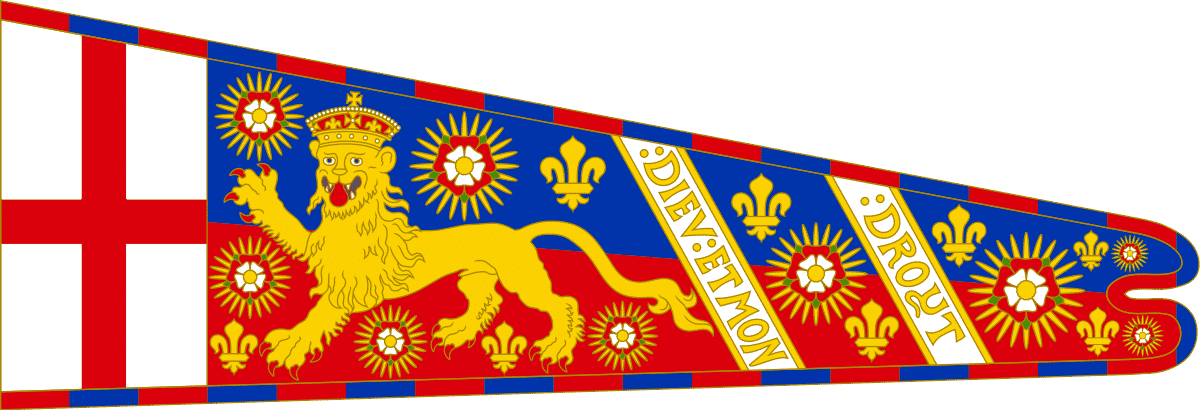
For two weeks after Henry VII died, his body remained at Richmond. Masses and dirges were performed around him while preparations were finalized for the final opportunities to display the elaborate pageantry demonstrating the Tudors’ divine right to rule: the procession to Westminster Abbey and his interment there.
These are described for us in Letters and Papers. The procession – including all the heraldry that Henry VII could have desired – is the focus of the account; the actual interment gets short shrift at the end, with the frustrating summarizing that characterizes many L&P entries. Still, the essentials are there:
First came riding through the city of London the sword bearer and vice-chamberlain of London with two of the masters of the Bridgehouse to set the crafts in array. Then came the King’s messengers, two and two “with their boxes at their breasts,” trumpeters and minstrels. Then the Florentines, Venetians, Portingals, Spaniards, Frenchmen, Easterlings. Then gentlemen ushers, chaplains having no dignity, squires for the Body. Then the aldermen and sheriffs. Then came riding two heralds in coats of armour, a knight mourner on a courser trapped with black velvet bearing the King’s standard, “whose name is Sir Edward Darrell, after whom came knights,” chaplains of dignity as deans and other, the King’s Council and Knights of the Garter not being lords, the Chief Justice of Common Pleas, Chief Baron, Chief Justice of King’s Bench, Master of the Rolls; then the Crouched Friars on foot, the four orders of Friars singing; the canons of all places in London singing; the King’s chapel in their surplices and grey amices singing. Then came riding all the temporal lords and barons on the left hand and the abbots and bishops on the right. Then rode Sir Davie Owen bearing a steel helmet with a gold crown, Sir Edward Howard (second son of the Earl of Surrey, treasurer) armed with the King’s harness, his face uncovered and bearing the King’s battle-axe head downward resting on his foot; Sir Thomas Fynes bearing a rich armour embroidered with the arms of England; the Mayor of London carrying his mace. Then came the chariot bearing the corse (panoply and attendance described). Then followed the Duke of Buckingham, Earls of Arundel, Northumberland, Shrewsbury, Surrey, Essex, “and other, to the number of nine, being Knights of the Garter”; then nine henchmen on coursers trapped with black velvet the three foremost bearing “three caps of maintenance which three Popes had sent the King,” the next three bearing rich swords point downwards, the seventh bearing “a target of the arms of England otherwise called a shield crowned,” the eighth a helmet with a lion of gold on it, the ninth a spear covered with black velvet. Then followed Sir Thomas Brandon, Master of the Horse, leading a courser trapped with black velvet embroidered with the arms of England; then Lord Darcy, Captain of the Guard, with the Guard and many other gentlemen.
At the west door of St. Paul’s, the Bishop of London revested and mitered, received the corse. Describes how it was borne into the church, how the bishop officiated, assisted by the Abbots of St. Albans and Reading. The Lords then departed to the Bishop’s palace, watch was kept by the corse, and on the morrow were sung three masses by the Dean of Powles and the Bishop of London; and the Bishop of Rochester preached. Then all went to dinner and, at their return, before 1 p.m., the corse was solemnly borne back to the chariot and conveyed through Fleet Street and Charing Cross, where the Abbots of Westminster, St. Albans, Reading and Winchcombe, revested and mitered, with the whole convent of Westminster, met and accompanied it to the west door of Westminster Abbey; and there the Archbishops of Canterbury and York received and censed it. Subsequent service, at which the Bishop of Norwich read the first lesson, the Bishop of Lincoln the second, and the Archbishop of Canterbury the third. The lords then departed to the King’s palace, all save certain knights appointed to watch.
On the morrow the lords were in the church before six o’clock, masses were sung (1) by the Abbot of Westminster, (2) by the Bishop of Winchester with the Abbot of St. Albans as his deacon and Abbot of Reading as sub-deacon, and (3) by the Archbishop of Canterbury with the Bishop of Lincoln as deacon and Bishop of Norwich as sub-deacon. Describes the subsequent ceremony minutely, from a herald’s point of view, noting how the Earl of Derby and the Earl of Arran “otherwise called the Scottish lord” stood together, how Sir Edward Howard rode into the church, the offerings made, &c.
Letters & Papers, Henry VIII
***
If you like my posts, you’ll love my books! My Seymour Saga trilogy tells the gripping story of the short-lived dynasty that shaped the Tudor Era. Jane the Quene skews romantic, The Path to Somerset is pure Game of Thrones (without the dragons), and The Boy King is a noir coming-of-age. Get them now through Amazon, Barnes & Noble, Kobo, and Apple, or even your local independent bookstore!

(PS Already read them? Did you love them? Then please review them – even just a stars rating! It makes a huge difference in helping new readers find them and would mean the world to me!)

Be First to Comment